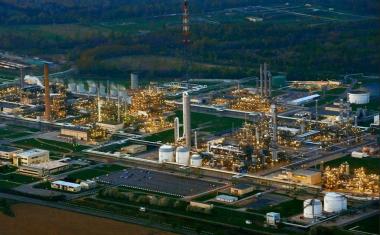Shale Gas Bonanza


Feedstocks - The rest of the world will have difficulties replicating the shale gas boom in the U.S. despite having plentiful reserves of the gas. Furthermore, there could be long delays before even significant amounts of shale gas are produced outside North America because of technological, economic and regulatory barriers. These were the key messages conveyed by some speakers at the Gastech Conference and Exhibition at the ExCel in London in October.
"There is an abundance of shale gas and shale oil," said Per Magnus Nysveen, partner at Rystad Energy, a consultancy in Oslo, Norway, which has assessed shale gas resources across the world. "(Could it be) an American miracle that the rest of the world may never experience? We believe that there is a long way to go from unconventional resources to profitable production for all formations we have assessed."
US and Canada have Advantages
The U.S. and to some extent Canada currently have unique advantages in having ideal geology for shale gas production as well as the infrastructure, a well-established regulatory regime and technological know-how, the conference was told. As a result the shale gas industry in the U.S. grew by 45% annually from 2005 to 2010 and now account for 24% of overall gas production in the country against 4% in 2005. By 2030 the U.S. government expects shale gas to supply half of the country's demand for gas.
Shale gas (as well as oil), which is locked in fine-grained sedimentary rock, has been produced in small quantities in the U.S. for decades. Major recent improvements in technologies for horizontal drilling combined with hydraulic fracking, which applies water mixed with chemicals to create fissures in the rock to extract the natural gas, have been a big impetus behind the U.S. shale gas bonanza.
Concerns about the Safety of Fracking
Despite concerns across the U.S. about the safety of fracking, particularly its potential to pollute local water supplies, the shale gas sector believe that it has demonstrated its ability to protect human health and the environment from the effects of production of the gas.
"Thousands and thousands of wells have been drilled in North America and to date there have been no cases of groundwater contamination by hydraulic fracking," said Rustom Mody, vice-president technology, completions and production, Baker Hughes, the U.S.-based oil and gas production services company. "None of the chemicals used are toxic. Most appear in every day materials including food and about 91% of what is pumped downhole is water."
The horizontal drilling and fracking technologies developed in the U.S. and their safety protocols and standards are being exported to exploit the huge shale gas resources across the world. Yet because of a variety of obstacles, output of shale gas outside the U.S. will be minimal - at least for the rest of the current decade. "We expect no significant commercial shale development before 2020 outside North America," said Mr Nysveen.
This was a view echoed by other speakers who believe that the high hopes of large quantities of shale gas and other unconventional sources of gas will not be realized for a while. In Europe, for example, there may be shale gas available on the market but it will be coming not from domestic producers but from U.S. imports.
"In many cases environmental, political and regulatory factors have been the greatest obstacles," said Noel Tomnay, head of global gas research at Wood Mackenzie, an Edinburgh-based energy consultancy. "A number of European governments have gone further and imposed moratoriums on fracking. As a result it's possible that within the next 5 to 10 years European gas demand could be served by more shale gas from the U.S. than Europe."
The Czech Republic could be latest among European countries to introduce a moratorium on shale-gas exploration. Currently there are moratoria in Romania, Austria and parts of Germany, while France and Bulgaria have banned it.
Most Limiting Factor is Geology
However environmental regulatory restrictions are not necessarily the biggest hurdles, particularly elsewhere in the world. Others include inadequate backup services and infrastructure, lack of favorable leasing regulations and high taxes, according to Mr Nysveen.
Like some other speakers, he pointed out that the "most limiting factor is geology" because of the demands geology can make on technology and costs.
Mr Tomnay said problems posed by geology in countries like China, which is estimated to have shale gas reserves around three times greater than those in the US, were holding back production projects.
"The geology has proven to be harder (than expected) in many areas," he said. "So much so that in China we expect the biggest non-conventional gas-growth story in the next five years will be coal-to-gas rather than shale or coal bed methane (CBM)."
The U.S. and Canada has ideal geological conditions for shale gas production, stemming from the Late Cretaceous period with carbonate contributing to the relatively high levels of brittleness of the shale rock in plays or geological formations like Eagle Ford and Niobrara, according to Mr Nysveen.
"There is still no evidence yet that analogues to the North American geology with homogeneous, unfolded and largely unfaulted, brittle and rich source rocks, can be found in other parts of the world," he said.
The minimum geological requirements are a total organic carbon content of at least 2%, 100-feet thicknesses and 2,000-feet depths or more of shale rock, clay content of up to 60% and a flat surface, Mr Nysveen added.
Due mainly to unfavorable geological conditions outside North America exploration and production of shale gas will be expensive so that producers will need relatively high gas prices to ensure adequate financial returns. "Companies won't invest in shale gas without high gas prices," said Mr Nysveen.
Yet currently there are downward pressures on gas prices in Europe and Asia where traditionally natural gas prices have been linked to crude oil prices. As a result gas prices are 2-3 times higher in Europe than in the U.S. while in Asia the gap is even wider.
Gas Demand in Europe
Gas supplies look likely to continue to outstrip demand with recent discoveries of enormous reserves in areas like East Africa. "The last two years have been the most successful for gas exploration for a generation," said Mr Tomnay.
Meanwhile gas demand has been going down in Europe because of competition from renewable sources of energy. In Germany gas demand dropped 17% in 2011 and is expected to remain largely flat this year and in 2013 mainly because of the impact of renewables, according to Norbert Kint, head of trading at EconGas, Austria. .
Also the effects of the shale gas bonanza in the U.S. are beginning to influence demand in Europe. In the UK gas demand went down by 16% in 2011 with an expected 7% fall this year, due to power generators switching to cheap coal exports from the US. Coal producers in the U.S. have had to divert output into export markets because power companies in the country have been cutting coal consumption to take advantage of low gas prices, according to Mr Kint. "The U.S. is now exporting roughly 25% more coal in the direction of Europe," he said.
Gas companies in the U.S. are also preparing plans to export to Europe shale gas-derived LNG and natural gas liquids (NGLs), such as ethane and propane to provide feedstocks for petrochemicals. Ineos Europe, the Swiss-based petrochemicals producer, has recently signed a 15-year deal with Range Resources of the U.S. for supplies of ethane and propane from the Marcellus shale gas play in Pennsylvania.
The prospect of low-priced gas from the U.S. possibly undercutting gas prices in Europe is thought to be a major factor behind a current lack of big investments in shale gas exploration and production in the region. In other parts of the world low gas prices are also delaying investments, particularly by international oil companies.
A Look into the Future of Shale Gas
Mr Nysveen reckoned that global production of shale gas outside the North America will rise to around 10 million of barrels of oil equivalent per day (boe/d) by the mid-2030s, rising to around 25 million boe/d by the mid-2050s. With the addition of shale gas output from the US, shale gas worldwide should account for 25% of global natural gas production by 2040.
A large proportion of the shale gas production outside North America in 20-30 years will come from a relatively small number of countries, such as Argentina, China, Brazil, India, Ukraine, Kazakhstan and Algeria. The biggest European producers will include Germany, France, Poland, Romania and Russia, according to Mr Nysveen. "The increase in shale gas production outside North America is going to be a slow process," he said.
Company
Rystad Energy ASFjordalleen 16
0250 Oslo
most read

Merck Acquires Chromatography Business from JSR Life Sciences
Merck to acquire the chromatography business of JSR Life Sciences, a leading provider of CDMO services, preclinical and translational clinical research, and bioprocessing solutions.


VCI Welcomes US-EU Customs Deal
The German Chemical Industry Association (VCI) welcomes the fact that Ursula von der Leyen, President of the European Commission, and US President Donald Trump have averted the danger of a trade war for the time being.

Novo Nordisk to Cut 9,000 Jobs Globally in Major Restructuring
Novo Nordisk announced a global workforce reduction of approximately 9,000 positions to streamline operations and reinvest DKK 8 billion (€1 billion) in growth opportunities for diabetes and obesity treatments.

Dow to Shut Down Three Upstream European Assets
Building on the April 2025 announcement, Dow will take actions across its three operating segments to support European profitability, resulting in the closure of sites in Germany and the UK.











